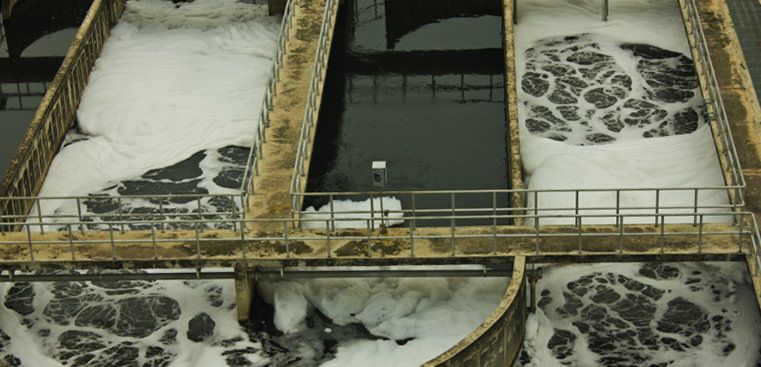Wastewater Treatment Plants Can Become Sustainable Biorefineries
Published on by Water Network Research, Official research team of The Water Network in Technology
In the future, wastewater treatment plants can have a broader function by being converted into biorefineries.
Text: Solveig Klug
Translator: Eva Medin

Photo: Mostphotos (Image Source: hb.se)
All of the world's wastewater treatment plants produce large quantities of sewage sludge, used today to produce biogas. In the future, treatment plants can have a broader function by being converted into biorefineries for the production of everything from biogas to different new materials.
Researchers in Resource Recovery at the University of Borås plan to validate a new concept in which they produce and extract fatty acids using membrane bioreactors, which in turn are used to produce the substances acetic acid and hydrogen.
Today, food waste and sludge from wastewater treatment plants are being used to produce biogas, but biogas competes with other energy types, such as wind power and solar energy, which makes the production of biogas alone limiting.
"But with our technology, we can develop a platform so that the treatment plants can be transformed into refineries where different chemical substances can be extracted and used to produce different types of materials. Fatty acids are a kind of intermediate product," explains Mohammad Taherzadeh, Professor in Bioprocess Technology, who heads the project.
Fatty acids can be further processed
Fatty acids have a function similar to that of sugar in various petrochemical and biological processes, namely, as sustenance for the microbes used in the processes. The successful production and extraction of fatty acids allows for further processing of these substances to other products, such as bioplastics or butanol. The amount of sewage sludge remaining in the process can be used as substrate – that is, the material that is to be converted – in a biorefinery.
"Another feature of the method is that carbon contained in the sludge can be extracted, and therefore there can be a circular process in which the carbon is used to remove nitrogen and phosphorus from the wastewater, and which we do not want to get into our waterways, as it leads to eutrophication. Today, treatment plants purchase large quantities of carbon for this process."
The project is ongoing until 31 May 2019 and is financed by Vinnova. It is being carried out in collaboration with Chalmers University of Technology and the companies Gryaab and Renova AB.
Transforming wastewater treatment plants to sustainable biorefineries by developing VFA platform
This project deals with proof of concept with experimental works in lab scale and techno-economical evaluation of using membrane bioreactors to produce and extract VFAs from sludge and food wastes to be used as carbon source for denitrification, and therefore promote circular economy for wastewater treatment plants.
Wastewater treatment plants in the world are producing a huge amount of sludge that is normally anaerobically digested (AD) to produce biogas and to reduce sludge volume. Food wastes are also a challenge in the world, where landfilling, composting and AD are the current treatments. While biogas production has economical challenges, such plants have to buy and add external carbon source such as ethanol or methanol into their denitrification process for removing nitrogen and phosphorous from wastewater. Volatile fatty acids (VFAs) are intermediate products during the AD process.
This project deals with proof of concept with experimental works in lab scale and technoeconomical evaluation of using membrane bioreactors to produce and extract VFAs from sludge and food wastes to be used as carbon source for denitrification, and therefore promote circular economy for wastewater treatment plants. VFA is produced from the sludge and/or in a mixture with food wastes by anaerobic digestion, where methane formation is inhibited and the VFAs are extracted via submerged membranes.
This project has the potential to be applied at all Swedish (more than 400 units) and international wastewater treatment plant providing them with a well-defined concept of a biotechnology-based circular economy. In addition, successful production and extraction of VFAs make the possibility to further process them to other products such as bioplastics or butanol and use the sludge as a substrate in a biorefinery.
Start date: 2018-11-05; End date: 2019-05-31
Source: University of Borås
Media
Taxonomy
- Wastewater Disposal
- Wastewater Use
- Bioreactor
- Reclaimed Wastewater
- Wastewater Phycoremediation
- Sludge Separation
- Industrial Wastewater Treatment
- Decentralized Wastewater
- Sludge Treatment
- Cooling Boiler & Wastewater
- Sludge Management
- Sludge Drying
- Waste Water Treatments
- Wastewater Treatment
- Wastewater Collection
- Solid Wastes & Wastewater Recycling
- Biotechnology
- Biodiversity
- Biochemistry
- Biogeochemistry
- Biofuels
- Waste Water Reclaimation
- Wastewater Treatment Plant Design
- Slurry Pumping
- Waste Water Serviceability
- Plant Biotech
- Water microbiology
- Biogas
- Wind Energy
- Solar Power
- Solar, Wind, Biogas, hydropower
- Bioenergy
- Renewable Energy Power
- Water Purification
- Renewable Water Resources
- Sludge Treatment & Management
- Biogas Plants
- Boiling & Chilled Drinking Water Filtration Appliances
- UF membranes/cassettes for waste water treatment MBR
- Packaged Water Treatment System
- Activated Sludge
- Wastewater Heat Recovery